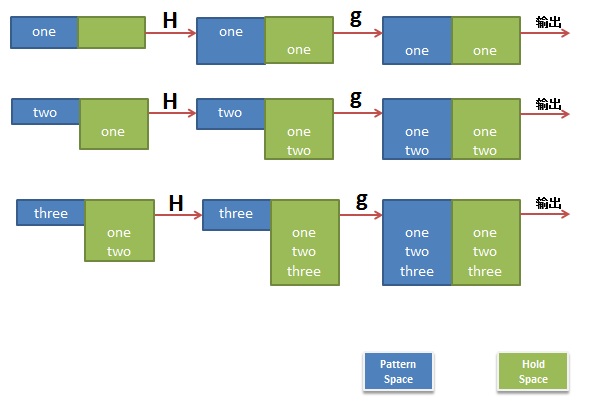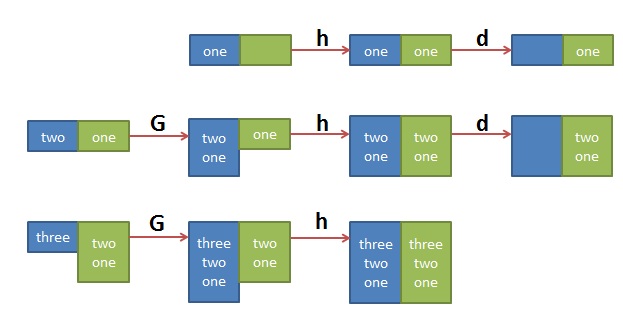sed的命令
让我们回到最一开始的例子pets.txt,让我们来看几个命令:
N命令
先来看N命令 —— 把下一行的内容纳入当成缓冲区做匹配。
下面的的示例会把原文本中的偶数行纳入奇数行匹配,而s只匹配并替换一次,所以,就成了下面的结果:
1 2 3 4 5 6 7 8 9 | $ sed'N;s/my/your/'pets.txtThis is your catmy cat's name is bettyThis is your dogmy dog's name is frankThis is your fishmy fish's name is georgeThis is your goatmy goat's name is adam |
也就是说,原来的文件成了:
1 2 3 4 | This is my cat\n my cat's name is bettyThis is my dog\n my dog's name is frankThis is my fish\n my fish's name is georgeThis is my goat\n my goat's name is adam |
这样一来,下面的例子你就明白了,
1 2 3 4 5 | $ sed'N;s/\n/,/'pets.txtThis is my cat, my cat's name is bettyThis is my dog, my dog's name is frankThis is my fish, my fish's name is georgeThis is my goat, my goat's name is adam |
a命令和i命令
a命令就是append, i命令就是insert,它们是用来添加行的。如:
1 2 3 4 5 6 7 8 9 10 11 12 13 14 15 | # 其中的1i表明,其要在第1行前插入一行(insert)$ sed"1 i This is my monkey, my monkey's name is wukong"my.txtThis is my monkey, my monkey's name is wukongThis is my cat, my cat's name is bettyThis is my dog, my dog's name is frankThis is my fish, my fish's name is georgeThis is my goat, my goat's name is adam# 其中的1a表明,其要在最后一行后追加一行(append)$ sed"$ a This is my monkey, my monkey's name is wukong"my.txtThis is my cat, my cat's name is bettyThis is my monkey, my monkey's name is wukongThis is my dog, my dog's name is frankThis is my fish, my fish's name is georgeThis is my goat, my goat's name is adam |
我们可以运用匹配来添加文本:
1 2 3 4 5 6 7 | # 注意其中的/fish/a,这意思是匹配到/fish/后就追加一行$ sed"/fish/a This is my monkey, my monkey's name is wukong"my.txtThis is my cat, my cat's name is bettyThis is my dog, my dog's name is frankThis is my fish, my fish's name is georgeThis is my monkey, my monkey's name is wukongThis is my goat, my goat's name is adam |
下面这个例子是对每一行都挺插入:
1 2 3 4 5 6 7 8 9 | $ sed"/my/a ----"my.txtThis is my cat, my cat's name is betty----This is my dog, my dog's name is frank----This is my fish, my fish's name is george----This is my goat, my goat's name is adam---- |
c命令
c 命令是替换匹配行
1 2 3 4 5 6 7 8 9 10 11 | $ sed"2 c This is my monkey, my monkey's name is wukong"my.txtThis is my cat, my cat's name is bettyThis is my monkey, my monkey's name is wukongThis is my fish, my fish's name is georgeThis is my goat, my goat's name is adam$ sed"/fish/c This is my monkey, my monkey's name is wukong"my.txtThis is my cat, my cat's name is bettyThis is my dog, my dog's name is frankThis is my monkey, my monkey's name is wukongThis is my goat, my goat's name is adam |
d命令
删除匹配行
1 2 3 4 5 6 7 8 9 10 11 12 | $ sed'/fish/d'my.txtThis is my cat, my cat's name is bettyThis is my dog, my dog's name is frankThis is my goat, my goat's name is adam$ sed'2d'my.txtThis is my cat, my cat's name is bettyThis is my fish, my fish's name is georgeThis is my goat, my goat's name is adam$ sed'2,$d'my.txtThis is my cat, my cat's name is betty |
p命令
打印命令
你可以把这个命令当成grep式的命令
1 2 3 4 5 6 7 8 9 10 11 12 13 14 15 16 17 18 19 20 21 22 23 | # 匹配fish并输出,可以看到fish的那一行被打了两遍,# 这是因为sed处理时会把处理的信息输出$ sed'/fish/p'my.txtThis is my cat, my cat's name is bettyThis is my dog, my dog's name is frankThis is my fish, my fish's name is georgeThis is my fish, my fish's name is georgeThis is my goat, my goat's name is adam# 使用n参数就好了$ sed-n '/fish/p'my.txtThis is my fish, my fish's name is george# 从一个模式到另一个模式$ sed-n '/dog/,/fish/p'my.txtThis is my dog, my dog's name is frankThis is my fish, my fish's name is george#从第一行打印到匹配fish成功的那一行$ sed-n '1,/fish/p'my.txtThis is my cat, my cat's name is bettyThis is my dog, my dog's name is frankThis is my fish, my fish's name is george |
几个知识点
好了,下面我们要介绍四个sed的基本知识点:
Pattern Space
第零个是关于-n参数的,大家也许没看懂,没关系,我们来看一下sed处理文本的伪代码,并了解一下Pattern Space的概念:
1 2 3 4 5 6 7 8 9 10 11 12 | foreach line in file {//放入把行Pattern_SpacePattern_Space <= line;// 对每个pattern space执行sed命令Pattern_Space <= EXEC(sed_cmd, Pattern_Space);// 如果没有指定 -n 则输出处理后的Pattern_Spaceif(sed option hasn't "-n") {print Pattern_Space}} |
Address
第一个是关于address,几乎上述所有的命令都是这样的(注:其中的!表示匹配成功后是否执行命令)
[address[,address]][!]{cmd}
address可以是一个数字,也可以是一个模式,你可以通过逗号要分隔两个address 表示两个address的区间,参执行命令cmd,伪代码如下:
1 2 3 4 5 6 7 8 9 10 11 12 13 14 | boolbexec = falseforeach line in file {if( match(address1) ){bexec = true;}if( bexec == true) {EXEC(sed_cmd);}if( match (address2) ) {bexec = false;}} |
关于address可以使用相对位置,如:
1 2 3 4 5 6 7 8 9 10 | # 其中的+3表示后面连续3行$ sed'/dog/,+3s/^/# /g'pets.txtThis is my catmy cat's name is betty# This is my dog# my dog's name is frank# This is my fish# my fish's name is georgeThis is my goatmy goat's name is adam |
命令打包
第二个是cmd可以是多个,它们可以用分号分开,可以用大括号括起来作为嵌套命令。下面是几个例子:
1 2 3 4 5 6 7 8 9 10 11 12 13 14 15 16 17 18 19 20 21 22 23 24 25 26 27 28 29 30 31 32 33 34 35 | $ catpets.txtThis is my catmy cat's name is bettyThis is my dogmy dog's name is frankThis is my fishmy fish's name is georgeThis is my goatmy goat's name is adam# 对3行到第6行,执行命令/This/d$ sed'3,6 {/This/d}'pets.txtThis is my catmy cat's name is bettymy dog's name is frankmy fish's name is georgeThis is my goatmy goat's name is adam# 对3行到第6行,匹配/This/成功后,再匹配/fish/,成功后执行d命令$ sed'3,6 {/This/{/fish/d}}'pets.txtThis is my catmy cat's name is bettyThis is my dogmy dog's name is frankmy fish's name is georgeThis is my goatmy goat's name is adam# 从第一行到最后一行,如果匹配到This,则删除之;如果前面有空格,则去除空格$ sed'1,${/This/d;s/^ *//g}'pets.txtmy cat's name is bettymy dog's name is frankmy fish's name is georgemy goat's name is adam |
Hold Space
第三个我们再来看一下 Hold Space
接下来,我们需要了解一下Hold Space的概念,我们先来看四个命令:
g: 将hold space中的内容拷贝到pattern space中,原来pattern space里的内容清除
G: 将hold space中的内容append到pattern space\n后
h: 将pattern space中的内容拷贝到hold space中,原来的hold space里的内容被清除
H: 将pattern space中的内容append到hold space\n后
x: 交换pattern space和hold space的内容
这些命令有什么用?我们来看两个示例吧,用到的示例文件是:
1 2 3 4 | $ catt.txtonetwothree |
第一个示例:
1 2 3 4 5 6 7 8 9 | $ sed'H;g't.txtoneonetwoonetwothree |
是不是有点没看懂,我作个图你就看懂了。

第二个示例,反序了一个文件的行:
1 2 3 4 | $ sed'1!G;h;$!d't.txtthreetwoone |
其中的 ’1!G;h;$!d’ 可拆解为三个命令
1!G —— 只有第一行不执行G命令,将hold space中的内容append回到pattern space
h —— 第一行都执行h命令,将pattern space中的内容拷贝到hold space中
$!d —— 除了最后一行不执行d命令,其它行都执行d命令,删除当前行
这个执行序列很难理解,做个图如下大家就明白了:

就先说这么多吧,希望对大家有用。
(全文完)





















